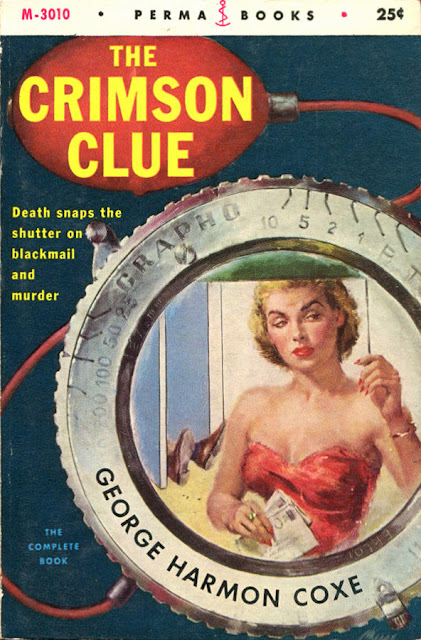

Ever since last month’s release of Shot in Detroit, Patricia Abbott’s second novel (following 2015’s Concrete Angel), with its camera-focused cover art, I’ve become aware of how often photographic equipment crops up on crime-novel jackets. Take, for instance, the image shown above and on the left. It’s the front from the 1955 Permabooks paperback edition of George Harmon Coxe’s The Crimson Clue (a work originally released in 1953). Coxe (1901-84) is a once-prominent and well-respected author (Erle Stanley Gardner described his books as “uniformly entertaining, gripping, and exciting”) whose star has faded over the last couple of decades, and who only seems recently to be gaining some notice again, thanks in part to his books having been brought into e-book circulation.
The Crimson Clue was the 14th novel featuring Coxe’s Kent Murdock, a mystery-solving crime photographer with the fictional Boston Courier-Herald newspaper, who first appeared in the 1935 tale Murder with Pictures. On The Thrilling Detective Web Site, Kevin Burton Smith calls Murdock “a refined, cleaned-up version of author Coxe’s rumpled, fast-talking crime photographer, Flashgun Casey, who appeared in the pages of Black Mask and several novels. Where Flashgun was a big, hot-tempered Boston Mick with a gift for gab and a nose for trouble, given to drink and fisticuffs, Kent is a more mature and professional man, urbane, sophisticated even. And married. His wife, Joyce, often teams up with him to solve cases, mostly in the Boston area, often involving Beacon Hill types. Together they appear in twenty-two novels.” Here’s a plot description of The Crimson Clue, provided by e-book publisher Open Road Media:
While taking pictures at a society wedding, Kent Murdock stumbles upon a murder.This cover of The Crimson Clue was painted by James Meese, about whom I have written periodically, and more of whose work can be enjoyed here.
Every society family has skeletons in its closets, but only the Cannings have a fresh corpse. Kent Murdock finds the dead man while taking pictures at the wedding of Patricia Canning and Roger Armington, scions of Boston’s most prominent—and camera-shy—families. Patricia and Murdock have been friends for years, and she invited him to photograph the wedding against her parents’ wishes. For the killer, Murdock’s appearance is very bad luck indeed. The dead man turns out to be Patricia’s ex-husband, whom she spent three days married to before the family pressured him into an annulment. He traveled to Boston in search of blackmail and found death instead.Whichever Canning killed him had hoped to sweep the murder under the rug. But Kent Murdock’s camera has a way of finding the truth, no matter how ugly it may be.
Our second illustration today—above, right—comes from the 1947 Bantam Books paperback reissue of Deadly Nightshade (1940), by Elizabeth Daly. It was Daly’s second novel, following Unexpected Night (1940), both books starring wealthy New York author and rare-book expert Henry Gamadge. As the Golden Age of Detection Web site explains, Daly (1878-1967) “works in the footsteps of Jane Austen, offering an extraordinarily clear picture of society in her time through the interactions of a few characters. In that tradition, if you knew a person’s family history, general type, and a few personal quirks, you could be said to know everything worth knowing about that person. Today the emphasis is on baring the darkest depths of psycho- and socio-pathology; contemporary readers raised on this style may find Ms. Daly both elitist and somewhat facile. But fans of classic movies and whodunits know that a focus on polished surfaces brings with it the possibility of hidden secrets and things unsaid; for those who disdain the obvious confessional style of today, the Gamadge books have much to recommend them.” This author would eventually pen 16 Gamadge novels.
Felony & Mayhem, the New York City publisher that reprinted Deadly Nightshade in 2013, provides the following synopsis of her yarn:
With talk of war all over the radio waves, Henry Gamadge is back in Maine, this time by invitation of Detective Mitchell whom he so aptly helped in Unexpected Night. Mitchell has a real puzzler on his hands: three different children have been poisoned with deadly nightshade, and there is no motive that could possibly link all three poisonings, beside the fact that the children all live in the same small community. Could the Gypsies, whose encampment is nearby, be involved? And was the death of a state trooper at about the same time a mere coincidence? Gamadge and Mitchell will eventually answer all these questions, while Elizabeth Daly paints a picture of a small community at the end of summer and right before a world war.Sadly, the artist responsible for the illustration fronting Bantam’s 1947 edition of Deadly Nightshade is uncredited.
READ MORE: “Archived Review: George Harmon Coxe—The Camera Clue” (Mystery*File).





1 comment:
Oh my, I love these covers featuring cameras. I happened upon one very nice paperback cover for a Coxe novel, but I did not realize there were so many other nice ones.
Post a Comment